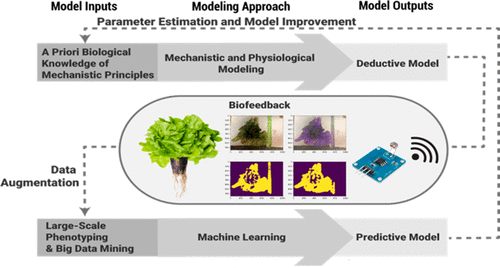当前位置:
X-MOL 学术
›
ACS ES&T Eng.
›
论文详情
Our official English website, www.x-mol.net, welcomes your
feedback! (Note: you will need to create a separate account there.)
Dynamically Controlled Environment Agriculture: Integrating Machine Learning and Mechanistic and Physiological Models for Sustainable Food Cultivation
ACS ES&T Engineering ( IF 7.4 ) Pub Date : 2021-11-13 , DOI: 10.1021/acsestengg.1c00269 Abigail Rae Cohen 1 , Gerry Chen 2 , Eli Matthew Berger 1 , Sushmita Warrier 3 , Guanghui Lan 4 , Emily Grubert 1 , Frank Dellaert 2 , Yongsheng Chen 1
ACS ES&T Engineering ( IF 7.4 ) Pub Date : 2021-11-13 , DOI: 10.1021/acsestengg.1c00269 Abigail Rae Cohen 1 , Gerry Chen 2 , Eli Matthew Berger 1 , Sushmita Warrier 3 , Guanghui Lan 4 , Emily Grubert 1 , Frank Dellaert 2 , Yongsheng Chen 1
Affiliation

|
Inefficiencies and imprecise input control in agriculture have caused devastating consequences to ecosystems. Urban controlled environment agriculture (CEA) is a proposed approach to mitigate the impacts of cultivation, but precise control of inputs (i.e., nutrient, water, etc.) is limited by the ability to monitor dynamic conditions. Current mechanistic and physiological plant growth models (MPMs) have not yet been unified and have uncovered knowledge gaps of the complex interplay among control variables. Moreover, because of their specificity, MPMs are of limited utility when extended to additional plant species or environmental conditions. Simultaneously, although machine learning (ML) can uncover latent interactions across conditions, phenotyping bottlenecks have hindered successful application. To bridge these gaps, we propose an integrative approach whereby MPMs are used to construct the foundations of ML algorithms, reducing data requirements and costs, and ML is used to elucidate parameters and causal inference in MPM. This review highlights research about control and automation in CEA, synthesizing literature into a framework whereby ML, MPM, and biofeedback inform what we call dynamically controlled environment agriculture (DCEA). We highlight synergistic characteristics of MPM and ML to illustrate that a DCEA framework could contribute to urban resilience, human health, and optimized productivity and nutritional content.
中文翻译:

动态控制的环境农业:将机器学习与机械和生理模型相结合以实现可持续粮食种植
农业中的低效率和不精确的投入控制对生态系统造成了毁灭性的后果。城市控制环境农业(CEA)是一种减轻耕作影响的建议方法,但对输入(即养分、水等)的精确控制受到动态条件监测能力的限制。当前的机械和生理植物生长模型 (MPM) 尚未统一,并揭示了控制变量之间复杂相互作用的知识空白。此外,由于它们的特殊性,当扩展到其他植物物种或环境条件时,MPM 的效用有限。同时,尽管机器学习 (ML) 可以发现跨条件的潜在相互作用,但表型瓶颈阻碍了成功应用。为了弥合这些差距,我们提出了一种综合方法,其中 MPM 用于构建 ML 算法的基础,降低数据需求和成本,ML 用于阐明 MPM 中的参数和因果推理。这篇综述重点介绍了 CEA 中关于控制和自动化的研究,将文献综合到一个框架中,通过该框架,ML、MPM 和生物反馈为我们所谓的动态控制环境农业 (DCEA) 提供信息。我们强调 MPM 和 ML 的协同特性,以说明 DCEA 框架可以有助于城市复原力、人类健康以及优化生产力和营养成分。这篇综述重点介绍了 CEA 中关于控制和自动化的研究,将文献综合到一个框架中,通过该框架,ML、MPM 和生物反馈为我们所谓的动态控制环境农业 (DCEA) 提供信息。我们强调 MPM 和 ML 的协同特性,以说明 DCEA 框架可以有助于城市复原力、人类健康以及优化生产力和营养成分。这篇综述重点介绍了 CEA 中关于控制和自动化的研究,将文献综合到一个框架中,通过该框架,ML、MPM 和生物反馈为我们所谓的动态控制环境农业 (DCEA) 提供信息。我们强调 MPM 和 ML 的协同特性,以说明 DCEA 框架可以有助于城市复原力、人类健康以及优化生产力和营养成分。
更新日期:2022-01-14
中文翻译:

动态控制的环境农业:将机器学习与机械和生理模型相结合以实现可持续粮食种植
农业中的低效率和不精确的投入控制对生态系统造成了毁灭性的后果。城市控制环境农业(CEA)是一种减轻耕作影响的建议方法,但对输入(即养分、水等)的精确控制受到动态条件监测能力的限制。当前的机械和生理植物生长模型 (MPM) 尚未统一,并揭示了控制变量之间复杂相互作用的知识空白。此外,由于它们的特殊性,当扩展到其他植物物种或环境条件时,MPM 的效用有限。同时,尽管机器学习 (ML) 可以发现跨条件的潜在相互作用,但表型瓶颈阻碍了成功应用。为了弥合这些差距,我们提出了一种综合方法,其中 MPM 用于构建 ML 算法的基础,降低数据需求和成本,ML 用于阐明 MPM 中的参数和因果推理。这篇综述重点介绍了 CEA 中关于控制和自动化的研究,将文献综合到一个框架中,通过该框架,ML、MPM 和生物反馈为我们所谓的动态控制环境农业 (DCEA) 提供信息。我们强调 MPM 和 ML 的协同特性,以说明 DCEA 框架可以有助于城市复原力、人类健康以及优化生产力和营养成分。这篇综述重点介绍了 CEA 中关于控制和自动化的研究,将文献综合到一个框架中,通过该框架,ML、MPM 和生物反馈为我们所谓的动态控制环境农业 (DCEA) 提供信息。我们强调 MPM 和 ML 的协同特性,以说明 DCEA 框架可以有助于城市复原力、人类健康以及优化生产力和营养成分。这篇综述重点介绍了 CEA 中关于控制和自动化的研究,将文献综合到一个框架中,通过该框架,ML、MPM 和生物反馈为我们所谓的动态控制环境农业 (DCEA) 提供信息。我们强调 MPM 和 ML 的协同特性,以说明 DCEA 框架可以有助于城市复原力、人类健康以及优化生产力和营养成分。











































 京公网安备 11010802027423号
京公网安备 11010802027423号